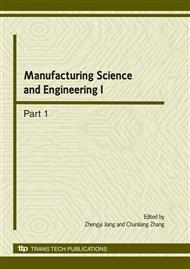p.1091
p.1097
p.1104
p.1109
p.1116
p.1120
p.1126
p.1130
p.1134
An Experimental Study of Metal Co-Injection Molding with Sequential Injection
Abstract:
An experimental study of co-injection molding which involves sequential injection of dissimilar metal feedstocks into a mold has been carried out. The effect of skin temperature and injection velocity on the material distribution of co-injection molded plates has been studied. It was found that the molding temperature was important in controlling skin-core distribution, while injection velocity seemed to play no significant role. The experimental results were analyzed by taking account of the relative viscosity of the two melts. It was demonstrated that the differences in rheological properties of the metal feedstocks involved are the primary variable determining the phase distribution of the molded parts.
Info:
Periodical:
Pages:
1116-1119
Citation:
Online since:
March 2010
Authors:
Price:
Сopyright:
© 2010 Trans Tech Publications Ltd. All Rights Reserved
Share:
Citation:


